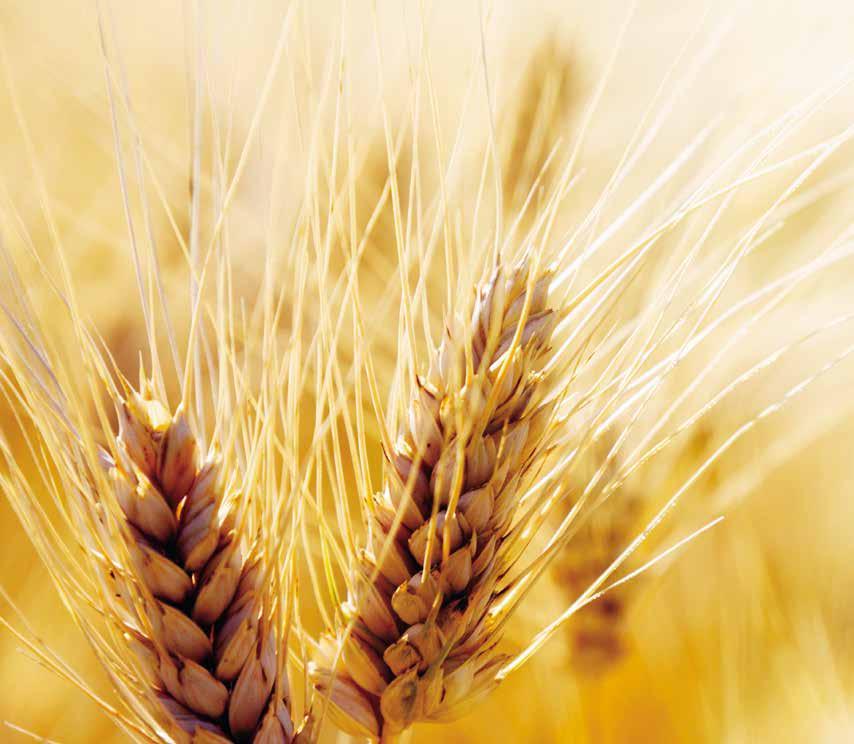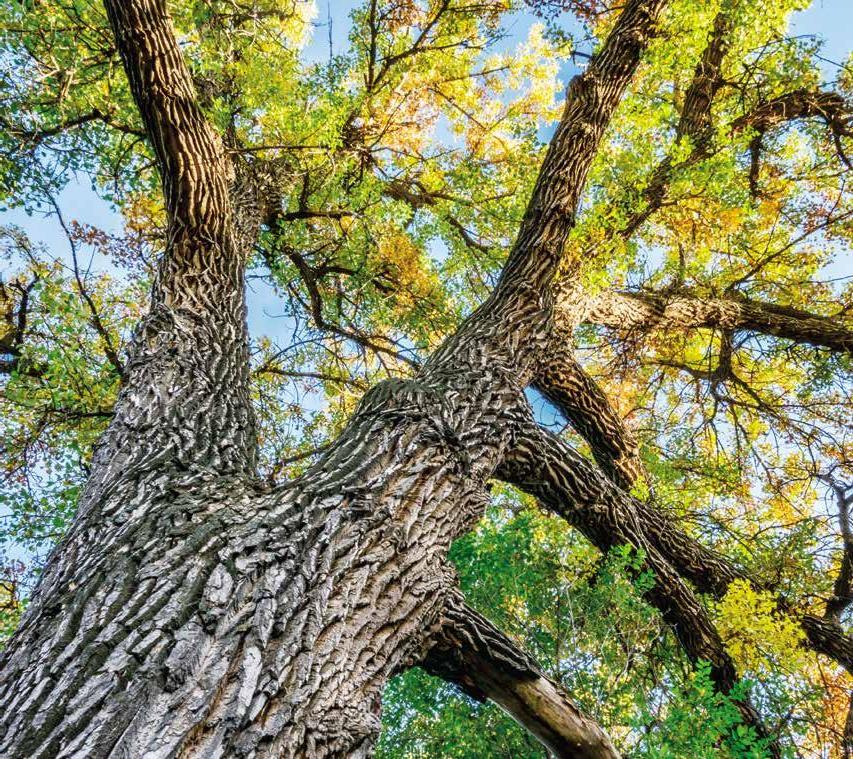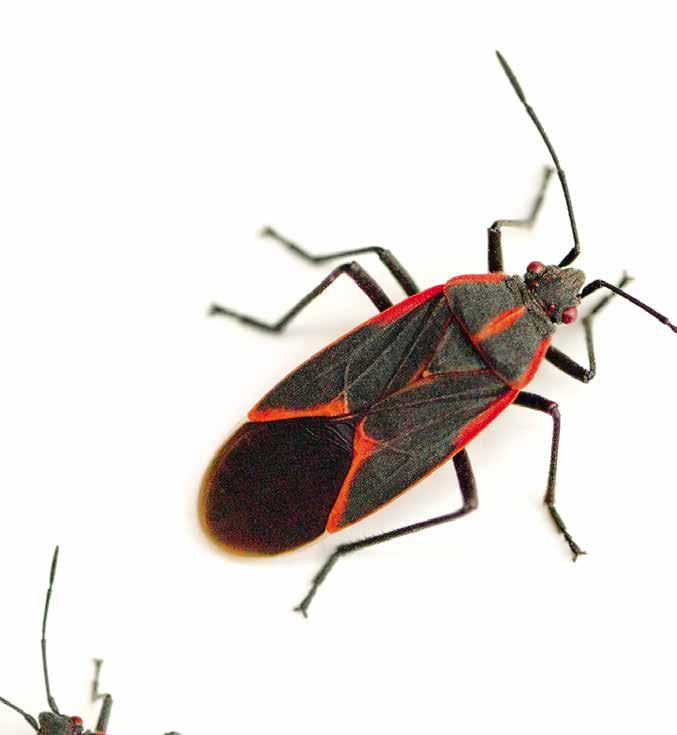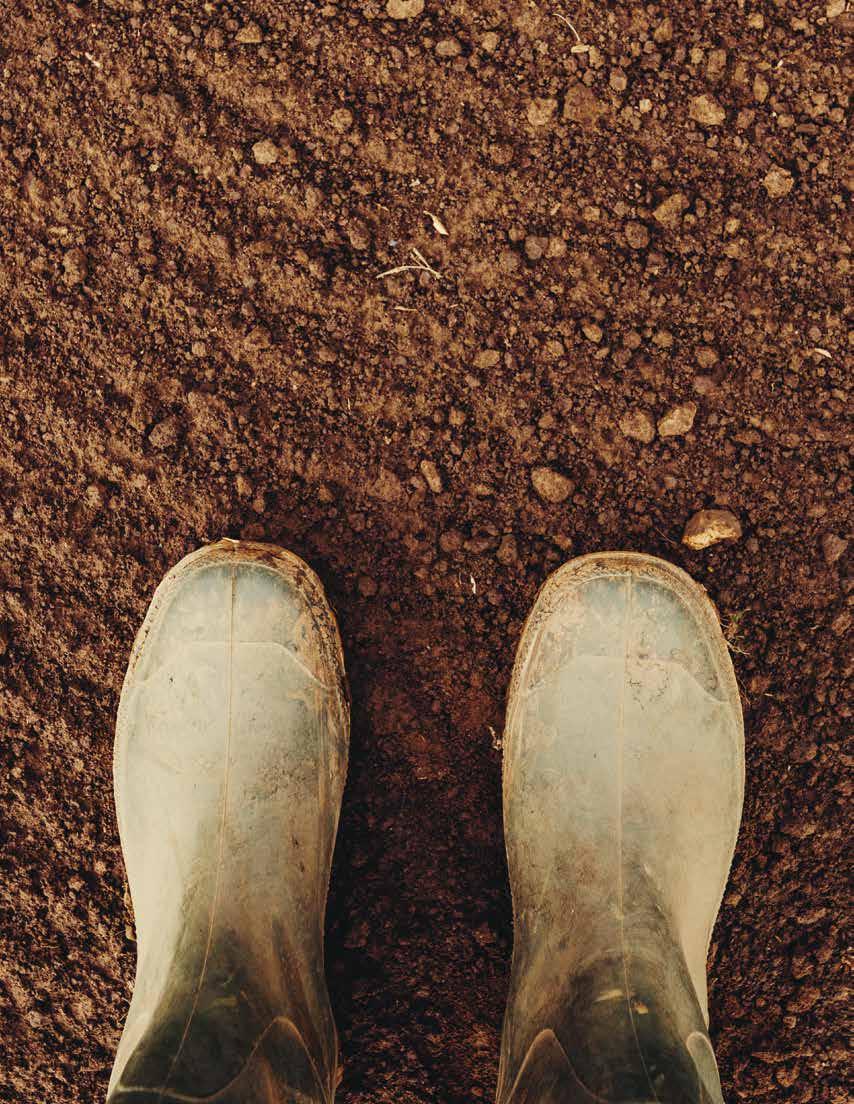
14 minute read
The Tractor and the Tree
by Mark Holman
Sometime before the final frantic years that preceded the end of the global civilization of billions, a tractor was left on the edges of a tilled field. It may have broken down in that very spot during a period lost to history. Or, it may have been left there because it was no longer useful in an age where human hand and foot power provided more utility. The antique from the age of iron machines that once quite literally moved the world, rested on the prairie surface, little more than a landmark and reminder of a different time. Sturdy and robust, the brick like solid steel mass would hold court in that very spot for centuries as the only thing higher than the grass for as far as could be seen. On the oral story maps of the prairie dwellers, the place had been called Lone Tractor Plain for as long as memory.
Advertisement
The tractor rested, unmoving through every season. Though it did nothing but exist, it created a unique, endemic community that welcomed, protected, and fostered life. The sequestered spaces beneath and around the tractor created microclimates within which all kinds of living things could sprout and flourish. Animals burrowed beneath it in protected warrens, while birds and small mammals nested within shrouded cavities. Hawks sat atop the higher points, surveying the landscape, while diminutive creatures cowered silently inside labyrinthine burrows deep within its bowels. In wetter seasons, water collected around the machine, and it became a perch and nesting place for waterfowl, while turtles basked in the sun on flanks just above the waterline. Moss and fungi found purchase on old gasket materials and in crevices that had collected layers of moist sediment blown in on the ever-present winds. Small bonsai-like communities of plant life grew where windblown soil had settled over the years in spaces and cavities. Like a derelict ship sunk in the middle of a vast ocean to create an artificial reef, the ancient tractor, like an iron atoll in a sea of grass, became a hub of life. The living and the unliving intertwined in a post-human symbiosis for a thousand years.
In the distance, standing like a lonesome sentinel in the ocean of grass, a man could see a solitary cottonwood tree on the horizon. A giant, venerable, stately tree towered above the surrounding plains beckoning as an oasis of shelter, an island of calm surrounded by windswept sameness and the severe extremes of open vastness. Cottonwoods, the resilient, long-lived giants of the plains, rooted deep and provided an island of shade and shelter in a place where there was little of either. The area around tree and tractor was a special place that broke the monotony of the prairie and provided comfort in the unforgiving landscape. The tree would make a great place to shelter for a few hours and wait out the midday heat that was beginning to beat down on him, the man thought.
As he walked closer, he saw what appeared to be a great, flowing mass of rusty rock beneath the tree. Stepping closer, he could make out the shape of what had once been a machine of the ancients. The ubiquitous hulks of what had been tractors, cars, and other forms of transport and power were everywhere in the landscape. Lacking purpose in the antediluvian age, they were little more than landmarks, sources of raw materials, and occasional shelter. In past epochs, humans had mined the Earth for resources to build an unrivaled, now myth-shrouded civilization with the help of these machines. Now, a much-diminished human population mined the limitless resources embodied within the things made by that mysterious and magical civilization of almost unfathomable extent and size. The ancients, often called the Old Ones in the prairie vernacular, had been great, but not enough to save themselves.
The onslaught of decades had left the general shape of the tractor intact, but the solid metal, eroded by the elements, now took on more of the form of an amorphous, red rock. In places, it retained its original linear right angles. In others, the wind, water, and seasons had sculpted sinuous curves and produced crumbling flakiness that gave the appearance of a wind-worn, iron-rich boulder. The wheels had been stripped away long ago to outfit someone’s hand or ox cart. Even the engine’s cylinder head, pistons, and crankshaft were missing. Any easily removable extrusion had been carted away, leaving a lump of frame, engine block, transmission, and drive train. Only one piston still rested in its cylindrical home. Long ago, the wayward piston had driven itself into the cylinder wall, abruptly silencing the life force of the machine. In the columnar cavity atop the life-ending calamity, a tiny community of plants now grew from the windblown soil collected over decades. Inches away, one side of the engine block had a large piece that had broken away. It likely had been carted off to be recast as something useful like an iron pot.
Decades before, when the area had dried after a wet spell, the tractor preserved just enough moisture beneath its hulking mass to shepherd some of the innumerable early summer cottonwood seeds to life. One had the tenacity and just the right conditions to continue and thrive. The giant cottonwood, stretching nearly 100 feet into the sky, spread its canopy almost as broadly, shading tractor and the ground around it. The tree had been nursed to life in the womblike cloister of the tractor, coddled by additional moisture and special conditions. Now, the cottonwood reciprocated the favor, shielding the unfeeling beast, more element than machine, from the most extreme vagaries of nature, adding years or centuries to its long existence. In a peculiar irony, the tractor, at one time a wholesale killer and scourge of trees, found itself protected by the shade of the tree. The strange partnership of chance, between life on the plains and an inanimate object, would endure for centuries. In years to come, the cycle of tractor nursing tree and tree shielding tractor would repeat itself several times. Which would be the last to grace the spot, or could it be sustained forever?
The tree eventually died. Hit by lightning, its life force slowly ebbed, and it melted into the ground, fertilizing the land around the tractor. Before its dying breath, seeds sprouted in the protected enclosure of the tractor. A century or so passed, and the tree once again died. This time, it left no descendants, and the remains of the tree decayed, enriching the soil beneath the tractor. In time, the tractor stood alone unshielded from wind and storm.
The tractor, exposed to the full force of its severe surroundings, struggled to remain whole. Centuries of wind, rain, freeze, and thaw, slowly eroded the tractor into a more organic, barely recognizable, entropic shape. The cycles of heat and cold, wet and dry, aided by soil and root, slowly worked at the joints until once tightly bolted spaces pulled apart and broke, spilling gears and contents within upon the ground. The shifted iron created new areas that fostered a fresh and vibrant community. Small animals nested within previously inaccessible spaces, while windblown soil and rain congregated within newly created reservoirs, encouraging new life communities depending on weather and season. New tree seeds sprouted, and the cycle began again. A new cottonwood tree rose in the space between the split halves of the tractor that had once been whole. Before long, it grew and began to push at the iron shroud that had nursed it to life. Too heavy to move, the tree started to grow around the metal. In time, the tree and the iron began to become one. The tractor, protected within the womb of the tree, would add centuries to its life as a ferrous whole.
A new man reciting the story map to Lone Tractor Plain, saw the only tree for miles around spread broadly on the horizon. As he walked closer, he could see that the tree was old, its trunk covered with cankers and deeply furrowed bark. Beneath, protruding from the base, was a rounded lump that looked like a rock. As he walked closer, the general shape of a human-made object emerged from the obscuring of countless seasons. In places, it was hard to tell where the tree began, and the machine ended. Walking closer, he could see two round engine cylinders emerging from the side of the tree, showing light through the bottom. He recognized it as one of the mysterious engines of the ancients. Some said that living populations of such apparatus existed in distant places. He found it hard to believe that any human could make such alchemical things. There had once been powerful magic in these machines. Cars, trucks, tractors, and wheeled machines of all types had once swarmed over the landscape like the buffalo now did. They had filled the land with roads and built all the wondrous creations of the Old Ones. Had the ancients truly made these machines? Or had the devices, as some said, made the ancients?
The people of the plains had stories about Tractor. They said Tractor had once roamed across the prairie, dominating and shaping the landscape in its image. According to the legendary saga The Song of Tractor, Tractor was the mythic iron ancestor of the buffalo that now dominated the plains. As part of a prophetic creation cycle of birth, transformation, destruction, and renewal, buffalo were also understood to be the ancestors of Tractor. The Song related how Tractor, unable to live in an altered world, died. Its life force returned to Earth and was then born again as flesh in the form of buffalo so humans could survive in the new world they created.
He remembered the time he had witnessed the prayer and ceremony called the Deus Ex Machina inside a silo fortress temple. The prayer began: “Tractor loved the world so gave itself so that man could have life…” Long ago, people and Tractor had lived in harmony and worked together to build great things. Humanity, unthinking, first extirpated buffalo from the land. Still unthinking, they used Tractor to strip the Earth and fouled the air with Tractor’s copious excrement. Almost before the bones of the buffalo had decomposed in the soil, Tractor found itself returning to its former embodiment, continuing the cycle and fulfilling the prophecy. The prayer continued: “This is my body given to you, forge so that you will live.” In the ceremony that coincided with the recitation, the iron body of Tractor was refashioned into the arrows, knives, and other tools used to hunt the buffalo. The ceremony ended with everyone in the room reciting the last line of the Deus after each strike of the hammer on hot iron. He could still hear it within the reaches of his memory: “we beat plowshares into swords to live in a new world until Tractor comes again.” The alternation of voice and ringing blow that echoed throughout the temple still sounded in his head all these many years later.
He settled down, resting his back against the tree, the hulk of the broken half of the tractor sitting about 6 feet away, created a comfortable hermitage that protected him from the elements. The soft rustling of the tree’s leaves above was soothing to listen to as they played their rhythmic, twisting dance on the light breeze. The smell of cottonwood touching his nose was a soothing elixir that overlaid the heavy, juicy fragrance of early summer grass. A slow parade of thousands of cottony airborne seeds drifted slowly past on the breeze. Twinkling in the sunshine, they floated on the wind, looking for a life-giving purchase upon which to put down roots and replicate the conditions he now enjoyed. A perfect spot to take a nap, sheltered from sight on all sides, he thought. It was an ideal place to rest unseen from any marauders that might be in the area.
Long ago, someone had built a small fire circle out of a mix of rocks and tractor parts at the place where the tractor sat opposite the tree. The thermal mass of the tractor would reflect and radiate heat into the area, warming both tree and man long after the fire had died. A great spot to spend a chilly night the man thought. The charred ring and soot-stained iron were a testament to a long list of travelers finding succor in this rare place of shelter.
He stared at the old machine, much of which had been stripped away long ago. He had wrested bits from similar contraptions as ore to manufacture tools and hardware. Many still used tools left by the ancients who seemed to have produced limitless quantities of every imaginable useful thing. The vast trade gathering that took place each year near the great river always hosted some new trove of fresh goods from a previously undiscovered hoard of the ancients. Last year, he traded for a comfortable pair of shoes with a sort of wave emblazoned on the side. They felt good on the feet, constructed from one of the mysterious substances of the ancients. He hoped this pair would last the season.
In a small, shaded space beneath a twisted, eroded place where the engine had once joined with the transmission, a small patch of plants grew. A small copse of mint to one side and a small plot of nettle to the other. Both plants that thrived in the conditions of that particular terroir. The man gathered some of the young growth and put it into a small pot of water. The container was made from the lightweight white metal of the ancients, quite possibly cast from the parts of some tractor. He kindled a small fire with the numerous dried cottonwood branches strewn around the tree. It was light and easy to break and burned quickly. It would be enough to warm a little water for tea. A restorative broth that refreshed in the hot midday tempered by shade. Feeling secure, he lay down with his back against the tree, resting fitfully on the soft, loamy bed formed beneath the tree by decades of accumulated and decomposed leaves. The smell of earthy must touched his nose as he rested. It emitted a soothing coolness, preserved from frostier seasons, slowly releasing into the early summer air. Before he drifted off to sleep, he spied one of the distinctive morel mushrooms protruding from the accumulated bed of leaves. He would pick it along with the other plants and tie them to his pack to dry. They would help to trade for another pair of the ancient’s comfortable shoes when he arrived at the next silo fortress.
Even though the spot was remote, centuries of visitors had chipped away at the edges of the machine, removing bits of metal to be refashioned to fit the needs of the age. Tractors were useless, but their bones and sinews fueled the inflorescence of a new iron age on the prairie. The concrete silo forts built by the ancients thrust skyward in phallic domination of the steppe. From within, savanna warlords schemed for control of the plentiful scraps left by the Old Ones. According to legend, long ago, the forts had only been containers for the vast quantities of seeds grown by the fruitful union of Tractor and the Old Ones. The man found it hard to believe that there had ever been a time of such peace when such wealth could be unprotected. According to The Song of Tractor, Tractor had brought stability, allowing food and peace to grow in unison. Since that mythical, archaic time of heroic deeds, the human-shaped landscape had returned to more natural rhythms, almost before the engines of the tractors had cooled.
Centuries flowed by on the unceasing river of time, and new passers-by used the shelter of tree and tractor as a comforting harbor that mellowed the harshness of every season. New animals and plants found a safe port, thriving in the unique sanctuary. Travelers cut off pieces of the metal, while weather wore down the remains. In time, only a few small shards and a stain on the ground remained. Grass found it impossible to grow in places now that the full sun blasted the bare ground saturated with microscopic remnants of the tractor and no moisture. The last descendant of the original cottonwood lived for several more years, spreading its fluffy seeds in the space where the tractor had long ago nurtured it’s first ancestor to life. Unlike the moist, fertile sheltered spaces tractor once provided, the seeds found nothing but desiccation on the dry, windswept hardpan which tractor had nurtured for a thousand years. In a place that had once offered shelter, fecundity, and life, now there was just wind and sun. For a thousand years, the tractor had nurtured plant, animal, human, and fungus as a sanctuary in a harsh sea of grass. Now there was nothing but wind, sun, and a bare, iron-stained spot where, for a brief blink of time, life had flourished.
MARK HOLMAN grew up in eastern North Dakota, lived for twenty years in south-central North Dakota and now lives in the far west in Williston, North Dakota. He has spent much of his life working in and around agriculture and education in the state. The story, with symbolic elements, happens in a distant future time.










